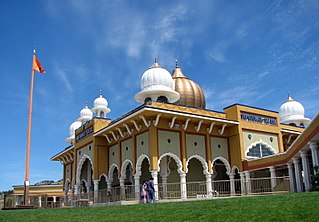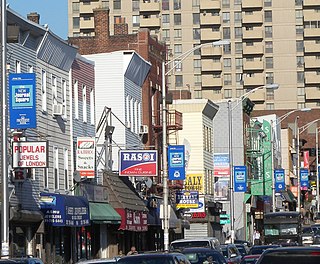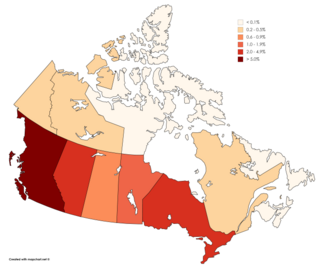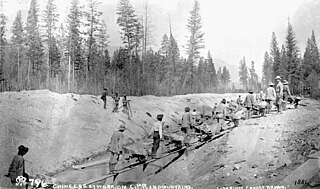
Xenophobia is the fear or dislike of anything which is perceived as being foreign or strange. It is an expression which is based on the perception that a conflict exists between an in-group and an out-group and it may manifest itself in suspicion of one group's activities by members of the other group, a desire to eliminate the presence of the group which is the target of suspicion, and fear of losing a national, ethnic, or racial identity.
The Asiatic Exclusion League was an organization formed in the early 20th century in the United States and Canada that aimed to prevent immigration of people of Asian origin.

South Asian Canadians are Canadians who were either born in or can trace their ancestry to the Indian subcontinent, which includes the nations of India, Pakistan, Bangladesh, Nepal, Sri Lanka, Bhutan, and the Maldives.
Racism has been reflected in discriminatory laws, practices, and actions at various times in the history of the United States against racial or ethnic groups. Throughout American history, white Americans have generally enjoyed legally or socially sanctioned privileges and rights, which have been denied to members of various ethnic or minority groups at various times. European Americans have enjoyed advantages in matters of education, immigration, voting rights, citizenship, land acquisition, and criminal procedure.
Asian immigration to the United States refers to immigration to the United States from part of the continent of Asia, which includes East Asia, South Asia, and Southeast Asia. Asian-origin populations have historically been in the territory that would eventually become the United States since the 16th century. The first major wave of Asian immigration occurred in the late 19th century, primarily in Hawaii and the West Coast. Asian Americans experienced exclusion, and limitations to immigration, by the United States law between 1875 and 1965, and were largely prohibited from naturalization until the 1940s. Since the elimination of Asian exclusion laws and the reform of the immigration system in the Immigration and Nationality Act of 1965, there has been a large increase in the number of immigrants to the United States from Asia.

Hinduism is a minority religion in the United States of America, constituting 1% of the population. The vast majority of American Hindus are immigrants mainly from India, some from Nepal, Sri Lanka, and Bangladesh, and a minority from Bhutan, Pakistan and Afghanistan. Additionally, the United States has a number of converts to Hinduism.
The Bellingham riots occurred on September 4, 1907, in Bellingham, Washington, United States. A mob of 400–500 white men, predominantly members of the Asiatic Exclusion League, with intentions to exclude Indian immigrants from the work force of the local lumber mills, attacked the homes of the South Asian Indians. The Indians were mostly Sikhs but were labelled as Hindus by much of the media of the day.
Anti-Hindu sentiment, sometimes referred to as Hinduphobia, is a negative perception, sentiment or actions against the practitioners of Hinduism.

Hinduism is the third-largest religion in Canada, which is followed by approximately 2.3% of nation's total population. As of 2021, there are over 828,000 Canadians of the Hindu faith.
Anti-Indian sentiment, a form of racism against Asians, also known as Indophobia or anti-Indianism, includes negative feelings, fear and hatred towards the Republic of India, Indian people, and Indian culture. Indophobia, in the context of anti-Indian prejudice, is "a tendency to react negatively towards people of Indian extraction, against aspects of Indian culture and normative habits". Its opposite is Indomania.

American Sikhs form the country's sixth-largest religious group. While the U.S. Census does not ask about religion, 70,697 Americans declared Sikh as their ethnicity in the 2020 census. In the 2021 Canadian census, 194,640 Canadians declared Sikh as their ethnicity while 771,790 Canadians declared Sikh as their religion, indicating that the Sikh American population may be around 280,329, or 0.08% of the total population. The U.S. Census Bureau estimated the adult Sikh American population at 78,000 in 2008. The Pew Research Center estimated the Sikh American adult population to be 140,000 and the total population at 200,000 in 2012 while the World Religion Database at Boston University estimated the American Sikh population to be at 280,000 in 2012. Sikh organizations like the Sikh Coalition and American Sikh Congressional Caucus estimate the Sikh American population to be as high as 1,000,000, but do not provide any sources for these figures; 500,000 nevertheless remains the most cited Sikh American population size. With 1% of Asian Americans being Sikh, and 90.7% of Sikh Americans being Asian American, the American Sikh population can be estimated at around 200,000-300,000 in 2021. The largest Sikh populations in the U.S. are found in California (52%), New York (11%), and Washington (6%).

Asian Canadians are Canadians who were either born in or can trace their ancestry to the continent of Asia. Canadians with Asian ancestry comprise both the largest and fastest growing group in Canada, after European Canadians, forming approximately 20.2 percent of the Canadian population as of 2021. Most Asian Canadians are concentrated in the urban areas of Southern Ontario, Southwestern British Columbia, Central Alberta, and other large Canadian cities.
Religious violence in India includes acts of violence by followers of one religious group against followers and institutions of another religious group, often in the form of rioting. Religious violence in India has generally involved Hindus and Muslims.

Indo-Canadians are Canadians who have ancestry from India. The term East Indian is sometimes used to avoid confusion with the Indigenous peoples of Canada. Categorically, Indo-Canadians comprise a subgroup of South Asian Canadians which is a further subgroup of Asian Canadians. According to Statistics Canada, Indians are one of the fastest growing communities in Canada, and one of the largest non-European ethnic groups.

Indian Americans are citizens of the United States with ancestry from India. The term Asian Indian is used to avoid confusion with Native Americans in the United States, who are also referred to as "Indians" or "American Indians." With a population of more than 4.4 million, Indian Americans make up approximately 1.35% of the U.S. population and are the largest group of South Asian Americans, the largest Asian-alone group, and the largest group of Asian Americans after Chinese Americans. Indian Americans are the highest-earning ethnic group in the United States.
The Pacific Coast race riots were a series of riots which occurred in the United States and Canada in 1907. The violent riots resulted from growing anti-Asian sentiment among White populations during the late 19th and early 20th centuries. Rioting occurred in San Francisco, Bellingham, and Vancouver. Anti-Asian rioters in Bellingham focused mainly on several-hundred Sikh workers recently immigrated from India. Chinese immigrants were attacked in Vancouver and Japanese workers were mainly targeted in San Francisco.
The Vancouver riots occurred September 7–9, 1907, in Vancouver, British Columbia, Canada. At about the same time there were similar anti-Asian riots in Bellingham, Washington, San Francisco, and other West Coast cities. They were not coordinated but instead reflected common underlying anti-immigration attitudes. Agitation for direct action was led by labour unions and small business. No one was killed but the damage to Asian-owned property was extensive.
South Asian Canadians in Metro Vancouver are the third-largest pan-ethnic group in the region, comprising 369,295 persons or 14.2 percent of the total population as of 2021. Sizable communities exist within the city of Vancouver along with the adjoining city of Surrey, which houses one of the world's largest South Asian enclaves.

Punjabi Canadians number approximately 950,000 and account for roughly 2.6% of Canada's population, as per the 2021 Canadian census. Their heritage originates wholly or partly from the Punjab region of India and Pakistan.

East Asian Canadians are Canadians who were either born in or can trace their ancestry to East Asia. The term East Asian Canadian is a subgroup of Asian Canadians. According to Statistics Canada, East Asian Canadians are considered visible minorities and can be further divided by ethnicity and/or nationality, such as Chinese Canadian, Hong Kong Canadian, Japanese Canadian, Korean Canadian, Mongolian Canadian, Taiwanese Canadian, or Tibetan Canadian, as seen on demi-decadal census data.










